ART PIECES
Piet Mondrian: Evening; The red tree
Visual arts
| 21-08-2020
When I started this website nearly a year ago, I planned to write regularly about visual art, especially about works of art that somehow affected me. There are a lot of visual artworks I appreciate because they are cleverly made – either technically or in terms of content – but what I especially hope to find in a museum is work that moves me. Bas Jan Ader's work did this because it had (and has) something mysterious; it got me thinking. In 2009 I experienced a completely different way of being moved with the painting Evening; The red tree (1908-1910) by Piet Mondrian.
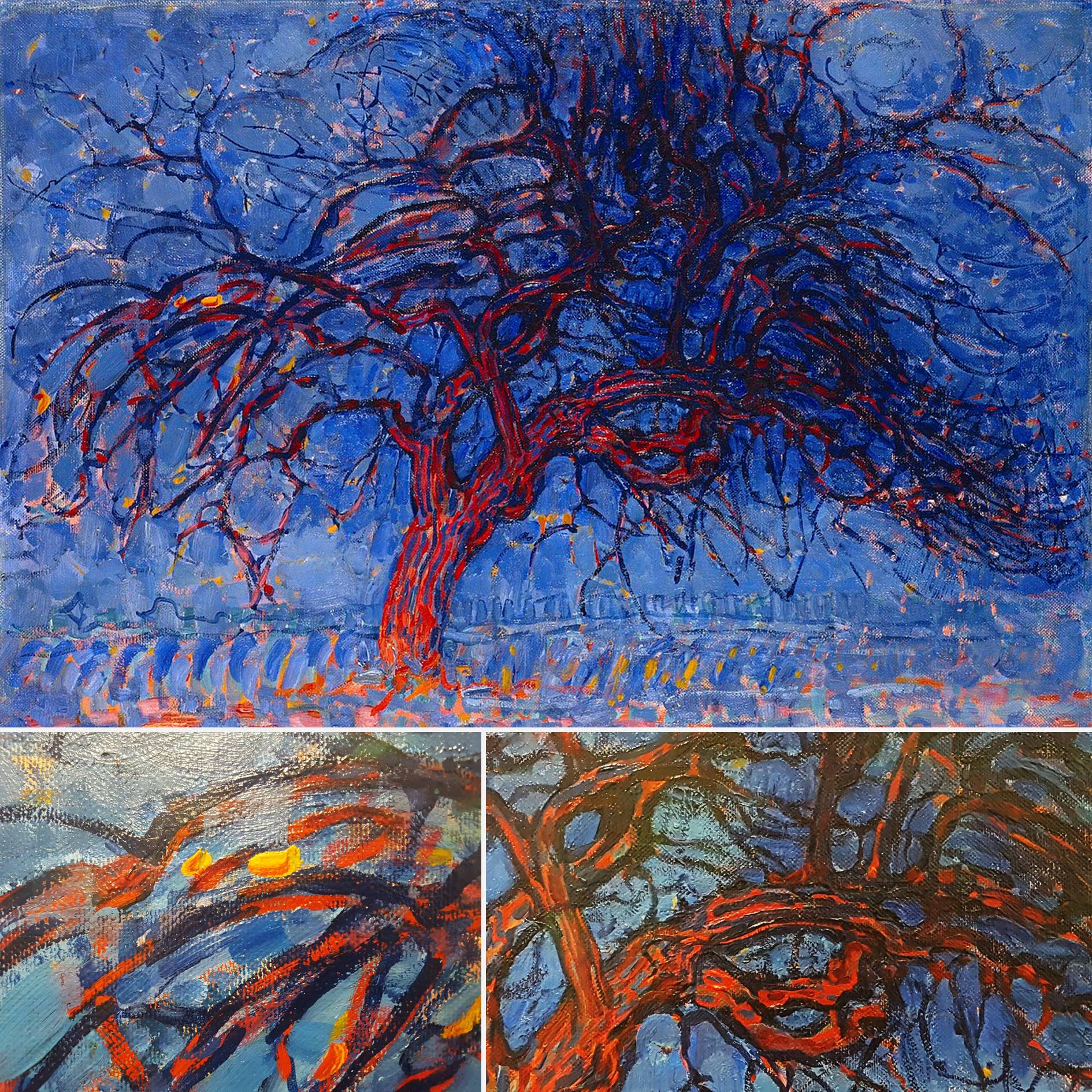
As a teenager I first came to the Gemeentemuseum in The Hague, and was inspired by Trees by the Gein: Moonrise (1907) by Mondrian, as I wrote earlier. I will probably have seen Evening on that visit too, but I don't remember that. Years later, with a fresh Bachelor Degree of Fine Art & Design in Education, I returned to the Gemeentemuseum and I remember like yesterday how I walked from one room into the other, turned to the right and suddenly came face to face with Evening and I experienced something I've never had before with a work of art. I can't quite describe the feeling, but it was like my heart stopped for a millisecond, a bit like when you have a fright, but positive. The painting with the stylized red tree against a blue background, painted with a loose touch, did something to me. In an attempt to maintain that feeling, I took a number of photos, but that's the crux of course: a painting speaks much less in a photo than in real life. Seeing the relief of the paint 'in person' and how the light falls on it, gives a completely different experience than seeing a suggestion of it on a smooth surface – that, of course, is all an image of a painting is.
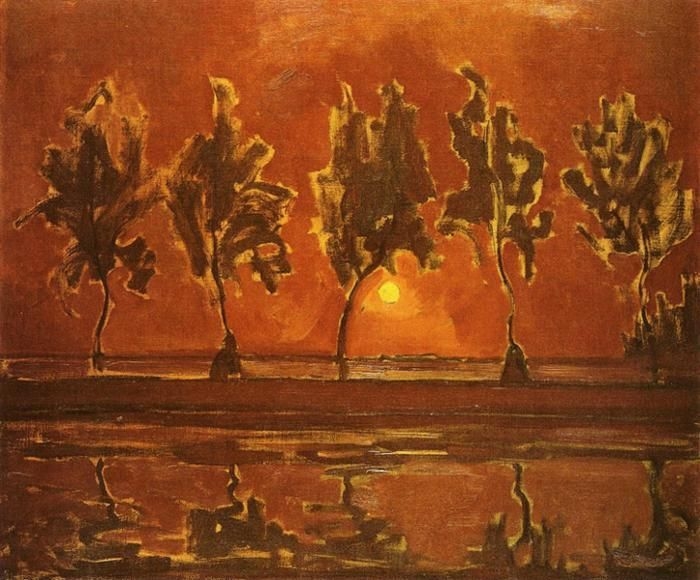
Since 2009 I have visited the Gemeentemuseum – nowadays Kunstmuseum – several times and each time I also take some time to look at Evening; The red tree, but I never experienced the enchantment of that one time. Nevertheless, I still find it a very intriguing painting. As a teacher of visual education (a combination of drawing and crafts) I used Mondrian's work to explain the concepts figurative, abstract, abstracting and stylizing. As far as I'm concerned, paintings such as Evening are the link you need to appreciate Mondrian's later work. While many people see Mondrian's abstract compositions as work in the category 'my little sister could do that' – an underestimation in itself – they are the ultimate result of Mondrian's quest for higher art. It has been my experience that it helps if you can show that Mondrian started with figurative work and was therefore able to 'paint well' in the eyes of the general public, and that he gradually stylized and at a certain point also abstracted, until the recognition was completely gone from the depiction. Good abstracting is at least as difficult as painting a good recognizable representation.
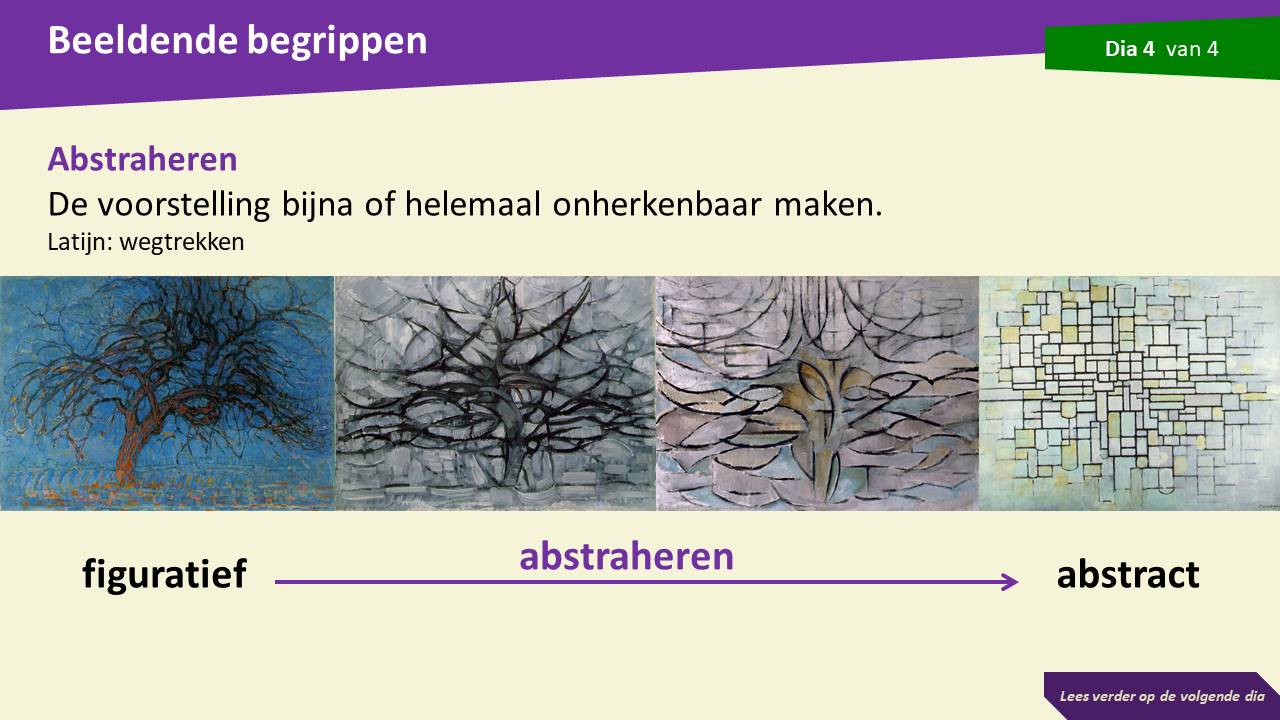
The painting Evening; The red tree lends itself very well to showing Mondrian's abstracting process, because the work can be beautifully placed next to The grey tree (1911) and Flowering apple tree (1912). You can see very clearly how the tree becomes less and less recognizable as a tree, until an unrecognizable collection of lines and shapes has been created. Tree: study for The grey tree shows very good that Mondrian didn't just put some lines on the canvas to get something tree-like, but that he observed very well how a tree is put together, then extracted defining structures from it and then stylized that. The same process on the borderline between figurative and abstract, which I find extremely fascinating, can be seen very beautifully in Still life with ginger pot 1 and Still life with ginger pot 2, both from 1912.
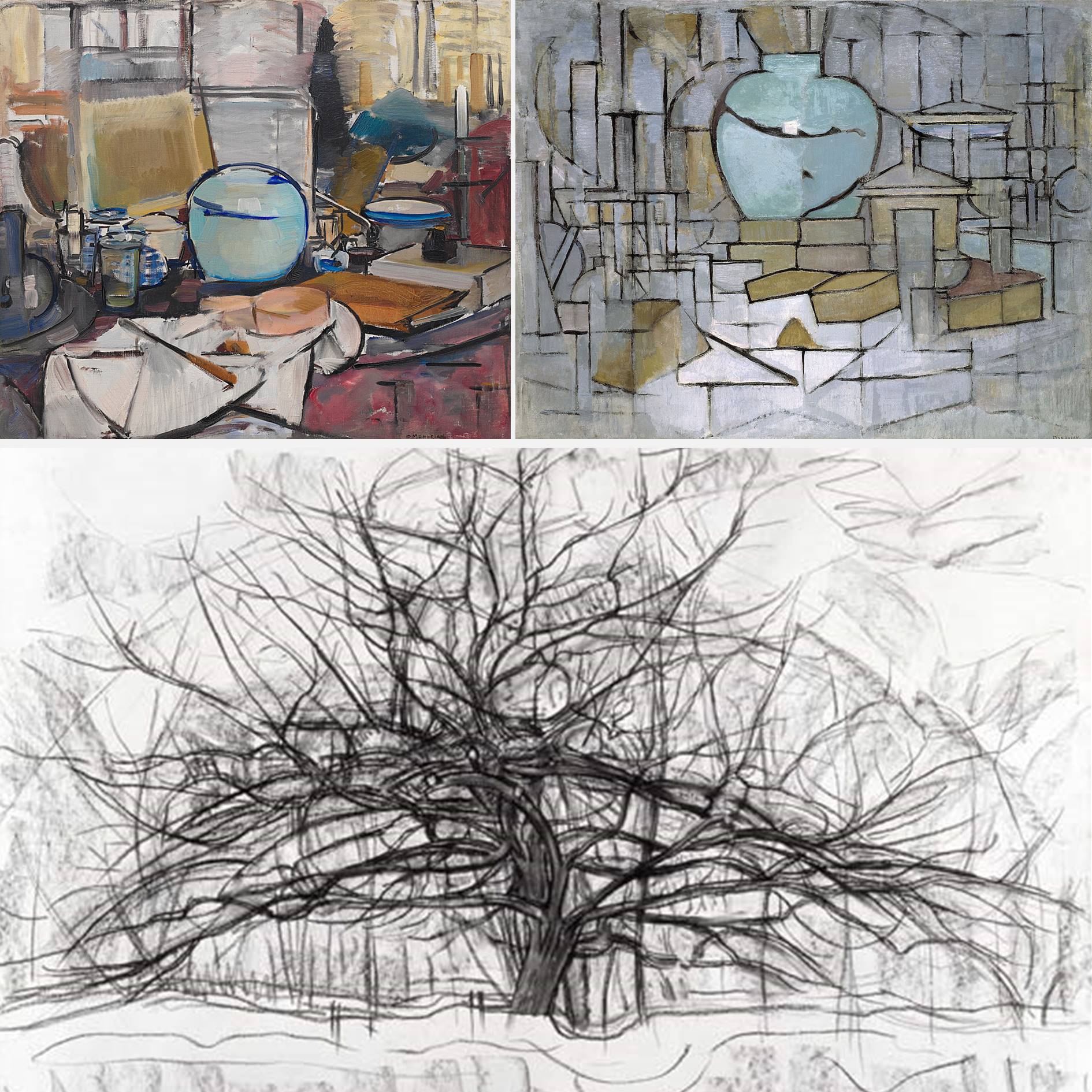
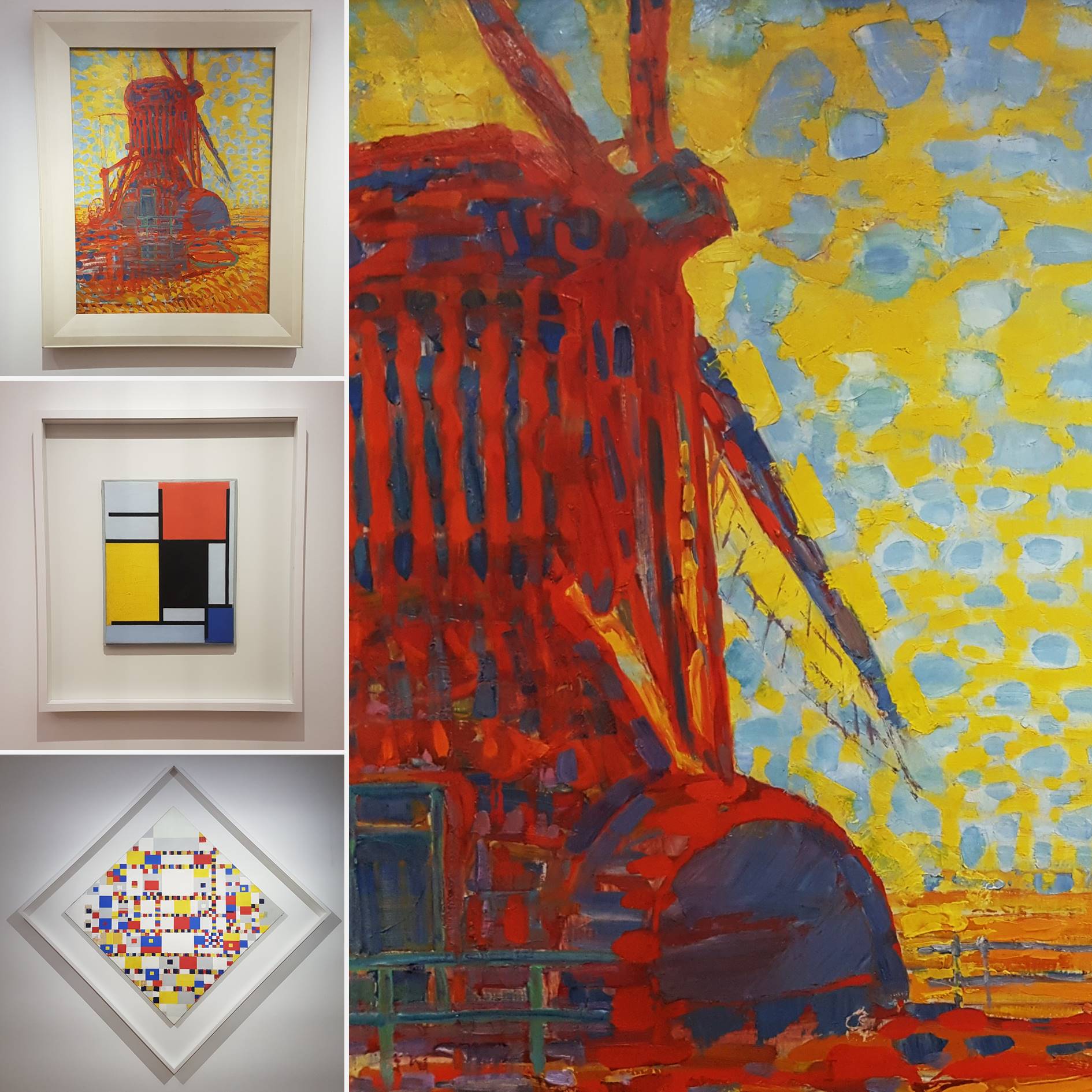

Piet Mondrian, Evening; The red tree (1908-1910) with two details below
Skipped heartbeatAs a teenager I first came to the Gemeentemuseum in The Hague, and was inspired by Trees by the Gein: Moonrise (1907) by Mondrian, as I wrote earlier. I will probably have seen Evening on that visit too, but I don't remember that. Years later, with a fresh Bachelor Degree of Fine Art & Design in Education, I returned to the Gemeentemuseum and I remember like yesterday how I walked from one room into the other, turned to the right and suddenly came face to face with Evening and I experienced something I've never had before with a work of art. I can't quite describe the feeling, but it was like my heart stopped for a millisecond, a bit like when you have a fright, but positive. The painting with the stylized red tree against a blue background, painted with a loose touch, did something to me. In an attempt to maintain that feeling, I took a number of photos, but that's the crux of course: a painting speaks much less in a photo than in real life. Seeing the relief of the paint 'in person' and how the light falls on it, gives a completely different experience than seeing a suggestion of it on a smooth surface – that, of course, is all an image of a painting is.

Piet Mondrian, Trees by the Gein: Moonrise (1907)
EnchantmentSince 2009 I have visited the Gemeentemuseum – nowadays Kunstmuseum – several times and each time I also take some time to look at Evening; The red tree, but I never experienced the enchantment of that one time. Nevertheless, I still find it a very intriguing painting. As a teacher of visual education (a combination of drawing and crafts) I used Mondrian's work to explain the concepts figurative, abstract, abstracting and stylizing. As far as I'm concerned, paintings such as Evening are the link you need to appreciate Mondrian's later work. While many people see Mondrian's abstract compositions as work in the category 'my little sister could do that' – an underestimation in itself – they are the ultimate result of Mondrian's quest for higher art. It has been my experience that it helps if you can show that Mondrian started with figurative work and was therefore able to 'paint well' in the eyes of the general public, and that he gradually stylized and at a certain point also abstracted, until the recognition was completely gone from the depiction. Good abstracting is at least as difficult as painting a good recognizable representation.

Slide from a PowerPoint I made about abstracting, among other things, with works by Mondrian, including the red tree
A prize processThe painting Evening; The red tree lends itself very well to showing Mondrian's abstracting process, because the work can be beautifully placed next to The grey tree (1911) and Flowering apple tree (1912). You can see very clearly how the tree becomes less and less recognizable as a tree, until an unrecognizable collection of lines and shapes has been created. Tree: study for The grey tree shows very good that Mondrian didn't just put some lines on the canvas to get something tree-like, but that he observed very well how a tree is put together, then extracted defining structures from it and then stylized that. The same process on the borderline between figurative and abstract, which I find extremely fascinating, can be seen very beautifully in Still life with ginger pot 1 and Still life with ginger pot 2, both from 1912.

The two still lifes with ginger pot and the study for The grey tree (detail)
What these still lifes lack, just like The grey tree and Flowering apple tree, are the popping primary colours that characterize his later work. Precisely because Mondrian puts bright red against a fairly soft blue background, the tree in Evening pops off the canvas. Those strong color contrasts, another thing I can get very excited about, are also very beautiful in Mill; Mill in sunlight (1908). In that work, the third primary color, yellow, plays a greater role than in Evening and in certain parts of the canvas you can also already see more announcements of the cubist composition that is inextricably linked to the name Mondrian, while the other works I mentioned in this paragraph are of a later date. This goes to show that the development of an artist is a process, a quest, and that it doesn't go in a straight line.
Left, from top to bottom: Mill; Mill in sunlight (1908), Composition with Red, Yellow, Black, Blue and Grey (1921) and Victory Boogie Woogie (1942-1944). Right: detail of Mill; Mill in sunlight
Sources
- Painting Evening; The red tree: By Piet Mondrian - Unknown source, Public Domain, Wikimedia Commons.
- Painting Trees by the Gein: Moonrise: By Piet Mondrian - Unknown source, Public Domain, Wikimedia Commons
- Painting Still life with ginger pot 1: By Piet Mondrian - www.guggenheim.org:Home:Info:Pic, Public Domain, Wikimedia Commons
- Painting Still life with ginger pot 2: By Piet Mondrian - Unknown source, Public Domain, Wikimedia Commons
- Drawing Tree: study for The grey tree: kunstkopie.nl
- The other images are my own photos.
